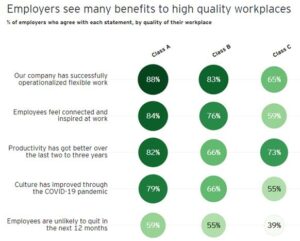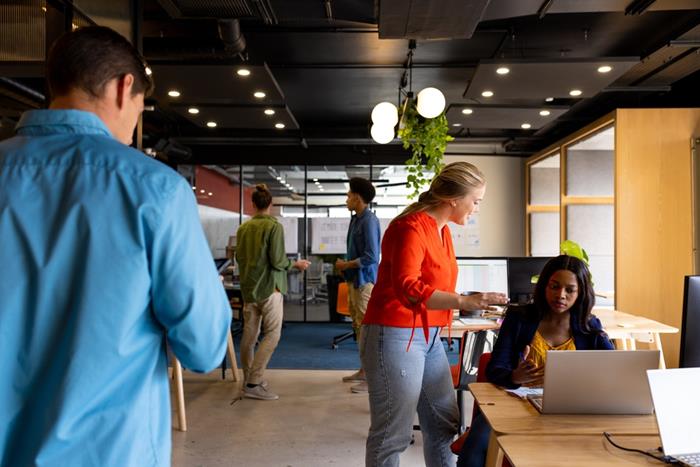Recent years filled with global disruptions and redirections in the realities of work have redefined for many organisations the role of the office, and what is the right mix of virtual and in-person work.
Expectations for flexibility and a “work from anywhere” mentality have promoted a more agile and innovative digital working world, while also forcing a paradigm shift for best practices in organisational design, culture, and how best to use in-person touchpoints to cultivate stronger and more resilient teams.
There is already a broad spectrum of response to this “next normal” of flexible work, even though some strategies show better outcomes than others.
While some organisations may have felt an impulse to mandate returns to the office, new data is revealing that the creating the right office/real estate environment, paired with the right workforce strategy, can differentiate sustainable value generation from mere sluggish survival.
A tale of two real estate strategies
On the one hand, some organisations are choosing to exit long-term prime Class A real estate—often the fanciest, best-equipped and most impressive space—because it is surplus to requirements. More broadly, research from Knight Frank shows that 50% of the largest global organisations they surveyed—those with more than 50,000 employees—plan to reduce their worldwide workspaces in the next three years.
Contrast this to research showing that 55% of smaller firms (those with up to 10,000 employees) expect to increase their global office space.
At the centre of many discussions around real estate is the shift towards a work-from-anywhere model, where employees spend some time working remotely and some in the office.
Exactly how hybrid work is defined is something of a sticking point.
The EY 2023 Work Reimagined Survey shows that for knowledge workers—whose work is traditionally based primarily on using analysis, critical thinking, interpersonal relationships or subject expertise in a professional setting—both employers (47%) and employees (37%) show a preference for two or three days of remote work per week.
Given a choice, however, half of all the employees surveyed would prefer no more than one day in the office a week, and 34% would like to be fully remote. Yet only a fifth of employers prefer fully remote work for knowledge workers.
The survey also shows that there are significant differences related to industry, region, age and gender. Financial services, and health and life sciences employees, for instance, expressed a preference for fully remote work (52%), which was considerably higher than employees in the energy industry (37%).
What is clear, however, is that hybrid working—whatever that looks like—is here to stay, and real estate choices can influence outcomes.
Why better real estate is better for business
With so much change in the reality of work, organisations need to assess their physical infrastructure as well as their digital capabilities, contributing to the most agile, adaptable and resilient workforce possible, no matter where people are working.
In fact, organisations should consider challenging the purpose of office space all together. It’s no longer just a regular site for work, but instead a hub for social connection, team-building and cultural experience.
The EY Work Reimagined Survey shows that, more than any physical feature of the office itself, employees cite the ability to remain socially connected to their colleagues as the primary draw of the office.
This is perhaps unsurprising, considering how the global health, geopolitical and economic challenges of recent years have contributed to many people’s sense of disconnection, and desire for higher-value interactions with others.
If the office as a social hub is a key draw for getting employees to return to the physical workspace (as opposed to being fully remote), it could be easy to argue the actual quality of the space itself doesn’t matter. Considering the cost of prime real estate, and with many businesses looking for cost savings, opting for Class B or Class C real estate could make perfect financial sense.
Looking more closely, however, data shows that organisations with higher-graded workplaces are more likely to report better productivity, culture, and a decreased likelihood of employees wanting to quit.

In an era when retaining staff is key, as is the importance of an organisation’s culture in attracting talent, businesses may well want to consider such benefits before they make any decisions around real estate, and use data to bolster the choice.
Organisations can consider employee pulse surveys or a cultural diagnostic of their workforce to determine how employees are working, and how best to align real estate strategy to the desired outcomes.
There is no escaping the fact that we are in the ‘next normal’ of work, and that means we should consider a real estate strategy that reflects current and future needs.
However, this doesn’t mean that there is a binary choice between in-person, remote or even hybrid work. Organisations need to make the right constellation of operational and strategic choices to identify and maximise how and where their workforce is working, while creating space to connect to the “why” of work.
Liz Fealy is Global People Advisory Services Tax deputy leader at EY.





